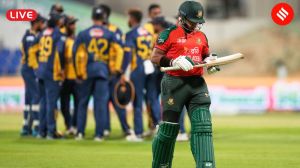Stay updated with the latest - Click here to follow us on Instagram
Dalai Lama turns 90: How will his successor be chosen and who gets to decide?
According to Tibetan tradition, the soul of a senior monk is reincarnated after death, and the Dalai Lama is no exception.
 Tibetan spiritual leader the Dalai Lama marks his 90th birthday (Tibetan calendar) at the Tsuglakhang temple in Dharamshala, June 30th. His Gregorian calendar birthday falls on July 6th. (AP Photo)
Tibetan spiritual leader the Dalai Lama marks his 90th birthday (Tibetan calendar) at the Tsuglakhang temple in Dharamshala, June 30th. His Gregorian calendar birthday falls on July 6th. (AP Photo)As the Dalai Lama approaches his 90th birthday this Sunday, the question of who will succeed the Tibetan spiritual leader has taken centre stage: not just among Buddhists, but also in political circles across China, India, and the United States.
The Nobel Peace Prize laureate, revered globally for his advocacy of nonviolence and compassion, is also seen as a symbol of resistance against Chinese control of Tibet. With succession potentially reshaping Tibetan religious authority and geopolitical equations, the process is closely watched by world powers.
A child chosen through signs
According to Tibetan tradition, the soul of a senior monk is reincarnated after death, and the Dalai Lama is no exception. The current, 14th Dalai Lama — born Lhamo Dhondup in 1935 in northeastern Tibet — was identified at age two after a search party, guided by visions and signs, believed he was the reincarnation of his predecessor.
When the child recognised items belonging to the 13th Dalai Lama and declared, “It’s mine, it’s mine,” their doubts were settled.
He was officially installed at the Potala Palace in Lhasa in 1940.
What happens after him?
The Dalai Lama, who has lived in exile in India since fleeing Tibet in 1959 after a failed uprising against Chinese rule, has indicated his successor will be born outside China.
In his 2025 book Voice for the Voiceless, he wrote that further details about the succession plan would be made public around his 90th birthday. The Tibetan parliament-in-exile, based in Dharamshala, says a framework is already in place to ensure continuity of leadership.
A key role in the process will be played by the Gaden Phodrang Foundation, which the Dalai Lama established in 2015 to support his religious and spiritual responsibilities. Senior aides and officers from the foundation are expected to guide the search and recognition of his reincarnation.
China insists it has the final say
Beijing, however, claims that its government has the authority to approve the Dalai Lama’s successor, citing laws rooted in Qing dynasty-era traditions. Officials have pointed to the golden urn ritual — a lottery system introduced in 1793 — as the official mechanism to determine reincarnations within China’s borders.
Chinese authorities argue that any reincarnation must occur within China and follow national laws. But many Tibetans see this as a political maneuver designed to control their spiritual leadership.
It is inappropriate for Chinese Communists, who reject religion “to meddle in the system of reincarnation of lamas” the Dalai Lama has said. He has urged Tibetans to reject any candidate “chosen for political ends… including those in the People’s Republic of China.”
India and US watch closely
India hosts the Dalai Lama and over 100,000 Tibetan Buddhists in exile. His presence in the Himalayan town of Dharamshala gives New Delhi a subtle but strategic advantage in its complex relationship with Beijing, reported Reuters.
Many Indians hold him in high regard, and he continues to have access to Indian institutions and media.
The United States has frequently voiced support for Tibetan autonomy and rights. In 2024, Joe Biden signed a law urging Beijing to negotiate on Tibet’s status and reaffirming Washington’s opposition to Chinese interference in the Dalai Lama’s succession.
US lawmakers have also made clear that any future Dalai Lama chosen under Chinese influence would not be recognised.
(With inputs from Reuters)
Photos



- 01
- 02
- 03
- 04
- 05




























